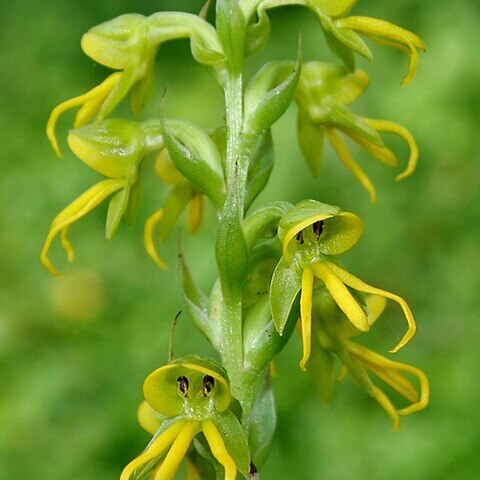Herbs, terrestrial. Tubers subglobose, ellipsoid, or oblong, fleshy, unlobed, neck with several slender roots. Stem erect, base often with tubular sheaths, above sheaths with leaves and sometimes several bractlike leaves above. Leaves 1 to several, loosely arranged or tufted, base contracted into amplexicaul sheaths. Inflorescence racemose, terminal, few to many flowered. Flowers resupinate. Sepals free; dorsal sepal connivent with petals forming a hood; lateral sepals spreading and reflexed. Petals simple or bilobed; lip often 3-lobed, base often spurred, sometimes saccate or spurless. Column short, both sides often with auricles (staminodes); anther erect, with distinct connective and 2 divergent locules, base of each often protruding and grooved; pollinia 2, granular-farinaceous, sectile, usually each by a long caudicle attached to a viscidium; viscidium naked, relatively small; stigmas 2, separate, convex or elongate, ± clavate, at base of column; rostellum usually stout and large, with arms parallel to basal grooves of anther, ± embracing caudicles.
Sep and lateral pet ± alike in form and color or the pet smaller, in our spp. the pet usually connivent with the dorsal sep to form a hood over the column, the lateral sep spreading or recurved; lip linear to ovate or obovate or 3-lobed, entire to toothed or fringed, prolonged backward at base into a spur; column short, capped by the broadly sessile anther; pollen-sacs 2, commonly separated by connective tissue or by part of the stigma, each containing a clavate (seldom bifid) pollinium attached at its narrow end to a usually ± exposed viscidium; perennial herbs, often from a fascicle of fleshy roots, the erect stem with basal or cauline, alternate lvs and a terminal spike or raceme. 500+, cosmop. (Coeloglossum, Gymnadeniopsis, Limnorchis, Piperia, Platanthera) Hybrids are fairly frequent, in spite of modal differences in pollinators.
Terrestrial or palustrine herbs with cauline or basal leaves or rarely the leaves reduced to bracts. Leaves thin to fleshy, usually prominent. Inflorescence few-to many-flowered, spicate or racemose; flowers various; bracts often large and conspicuous. Sepals subequal, free or connate at the bases, the dorsal erect, usually-concave, the laterals usually spreading. Petals similar to the sepals but usually smaller, or more or less deeply bifid (rarely trifid or polyfid). Lip simple or 3 or more-lobed, often adnate to the column, spreading or pendulous, spurred at the base. Column short, footless. Stigmas 2 or 1 stigma 2-lobed, often elongated into short or comparatively long processes. Anther erect, rarely more or less resupinate, persistent; pollinia (or pollen) granular, with short or sometimes long caudicles from the base.
Tuberous terrestrial orchids occurring as individuals or in loose groups. Tubers paired, oblong or globose. Leaves either arranged in a basal rosette or scattered loosely up the stem, rarely reduced to bracts. Inflorescence central on the rosette, mutiflowered, racemose. Flowers generally small, pale (cream, white, greenish or yellow). Dorsal sepal and petals overlap to form a galea. Lateral sepals free, flanking labellum, spreading or recurved. Petals porrect to spreading, with thin, thread-like accessory lobes. Labellum fixed to base of column, porrect to decurved. Labellum lamina usually 3-lobed and with a basal spur; lateral lobes thread-like, often tapered to a point; midlobe porrect, often shorter than lateral lobes; basal spur frequently longer than ovary. Column short.
Herbs perennial, terrestrial or semiaquatic, often rather succulent. Roots scattered along basal portion of stem, both slender and tuberous, fleshy; tuberoids usually spheroid. Stems: leaves basal, abruptly reduced to bracts or scattered, gradually reduced toward inflorescence. Leaves several, alternate, ascending to spreading, conduplicate, bases sheathing stem. Inflorescences terminal, lax to rather dense spicate racemes; bracts large and foliaceous to reduced. Flowers few to many, resupinate, pedicellate, sometimes showy; petals 2-lobed, lateral lobe on abaxial margin; lip 3-lobed, spurred at base; pollinaria 2; pollinia 2; viscidia free; stigma with 2 fleshy processes flanking or encircling mouth of spur. Fruits capsules, ellipsoid.
Column long or short; anther erect or reclinate, the loculi either adjacent or separated by a U-shaped connective; anther canals long or short, almost always adnate to side lobes of rostellum; auricles (staminodes) 2, sometimes 2-lobed; pollinaria 2, each with a sectile pollinium, long or short caudicle and a small, naked viscidium; stigmatic processes 2, long or short, usually free but sometimes joined in lower part to rostellum.
Leaves several–many, arranged along stem or clustered at the base, or with 1–2 basal leaves appressed to the ground and the cauline leaves sheath-like.
Lip entire or 3-lobed, spurred at base; the side lobes sometimes divided; the spur long or short, slender or saccate, often inflated at apex.
Sepals usually free, the dorsal sepal often forming a hood with the petals; lateral sepals spreading or reflexed.
Flowers usually resupinate, in African species green and/or white, rarely yellow.
Terrestrial, rarely epiphytic, herb with tuberoids or long fleshy roots.
Inflorescence terminal, 1 to many-flowered.
Petals entire, 2-lobed or bifid.
Stem unbranched.

